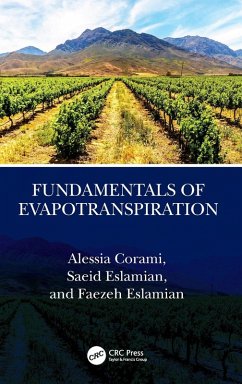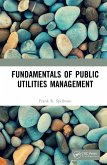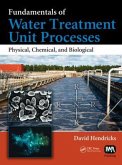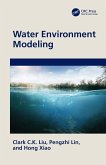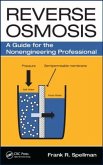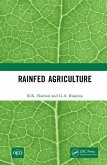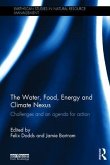- Gebundenes Buch
- Merkliste
- Auf die Merkliste
- Bewerten Bewerten
- Teilen
- Produkt teilen
- Produkterinnerung
- Produkterinnerung
Fundamentals of Evapotranspiration aims to determine simple methods to evaluate evapotranspiration and to examine the evolution of these methods over time. It compares and contrasts best practices and discusses the opportunities for harmonization among various methods.
Andere Kunden interessierten sich auch für
![Fundamentals of Public Utilities Management Fundamentals of Public Utilities Management]() Frank R SpellmanFundamentals of Public Utilities Management160,99 €
Frank R SpellmanFundamentals of Public Utilities Management160,99 €![Fundamentals of Water Treatment Unit Processes Fundamentals of Water Treatment Unit Processes]() David HendricksFundamentals of Water Treatment Unit Processes237,99 €
David HendricksFundamentals of Water Treatment Unit Processes237,99 €![Water Environment Modeling Water Environment Modeling]() Clark C K LiuWater Environment Modeling130,99 €
Clark C K LiuWater Environment Modeling130,99 €![Statistical Downscaling for Hydrological and Environmental Applications Statistical Downscaling for Hydrological and Environmental Applications]() Taesam LeeStatistical Downscaling for Hydrological and Environmental Applications156,99 €
Taesam LeeStatistical Downscaling for Hydrological and Environmental Applications156,99 €![Reverse Osmosis Reverse Osmosis]() Frank R SpellmanReverse Osmosis202,99 €
Frank R SpellmanReverse Osmosis202,99 €![Rainfed Agriculture Rainfed Agriculture]() R K NanwalRainfed Agriculture182,99 €
R K NanwalRainfed Agriculture182,99 €![The Water, Food, Energy and Climate Nexus The Water, Food, Energy and Climate Nexus]() The Water, Food, Energy and Climate Nexus203,99 €
The Water, Food, Energy and Climate Nexus203,99 €-
-
-
Fundamentals of Evapotranspiration aims to determine simple methods to evaluate evapotranspiration and to examine the evolution of these methods over time. It compares and contrasts best practices and discusses the opportunities for harmonization among various methods.
Hinweis: Dieser Artikel kann nur an eine deutsche Lieferadresse ausgeliefert werden.
Hinweis: Dieser Artikel kann nur an eine deutsche Lieferadresse ausgeliefert werden.
Produktdetails
- Produktdetails
- Verlag: Taylor & Francis Ltd (Sales)
- Seitenzahl: 164
- Erscheinungstermin: 22. Oktober 2024
- Englisch
- Abmessung: 234mm x 156mm x 11mm
- Gewicht: 422g
- ISBN-13: 9781032737034
- ISBN-10: 1032737034
- Artikelnr.: 70527614
- Herstellerkennzeichnung
- Libri GmbH
- Europaallee 1
- 36244 Bad Hersfeld
- gpsr@libri.de
- Verlag: Taylor & Francis Ltd (Sales)
- Seitenzahl: 164
- Erscheinungstermin: 22. Oktober 2024
- Englisch
- Abmessung: 234mm x 156mm x 11mm
- Gewicht: 422g
- ISBN-13: 9781032737034
- ISBN-10: 1032737034
- Artikelnr.: 70527614
- Herstellerkennzeichnung
- Libri GmbH
- Europaallee 1
- 36244 Bad Hersfeld
- gpsr@libri.de
Alessia Corami completed her degree in earth science at the University of Rome La Sapienza with her dissertation "Characterization of mortars and plasters from the archaeological site of Elaiussa Sebaste (Turkey) and from Quintili's Villa on the ancient Appian way in Rome in 1998." Later, she won a fellowship regarding isotopic chemistry at Geokarst srl AREA Science Park, analyzing organic and inorganic samples. In 2001, she won a fellowship at the Georesources and Geoscience Institute of Italian CNR for "Investigation on ancient emeralds to determine the original mine." In 2002, she won a Ph.D. fellowship at University of Rome La Sapienza for "Phosphate-induced heavy metals immobilization in aqueous solutions and soils." During her Ph.D. work, she spent seven months in the United States at Miami University (Ohio) working with Professor John Rakovan, attending the GLG 699.E course "Scanning Probe Microscopy: Theory and Application," and analyzing samples with AFM under Professor Rakovan's supervision. Later, she spent a period at University of California, Merced, working with Professor Samuel J. Traina and analyzing samples at high temperature and high pressure. In 2005, 2006 and 2008, she went to ESRF in Grenoble, working with Dr. D'Acapito and analyzing her Ph.D. samples. From 2007, she was a professor at Guglielmo Marconi University for five years, teaching two courses, Environmental Geology and Geomorphology. In 2014, she was a visiting professor at Karl Eberhard University of Tübingen (Germany) teaching (Bio)-remediation Technologies and Climate Change. During her career, she published articles about archaeometry, geochemistry and remediation techniques. She is a thesis supervisor and reviewer, and she is on the international editorial boards for some scientific journals as well as a member of many scientific organizations. After two years as visiting assistant professor at University of Louisiana, Lafayette she joined le Cerege at European Centre Research and Teaching in Geosciences de L'environment Technopôle de l'Arbois-Méditerranée. Saeid Eslamian received his Ph.D. in civil and environmental engineering from University of New South Wales, Australia, in 1998. Saeid was a visiting professor at Princeton University and ETH Zurich in 2005 and 2008, respectively. He has contributed to more than 1,000 publications in journals, conferences and books. Eslamian was honored as a 2-Percent Top Researcher by Stanford University for several years. Currently, he is a full professor of Hydrology and Water Resources and the Director of the Excellence Center in Risk Management and Natural Hazards. Isfahan University of Technology. His scientific interests are floods, droughts, water reuse, climate change adaptation, sustainability and resilience. Faezeh Eslamian is a Ph.D. holder of bioresource engineering from McGill University. Her research focuses on the development of a novel lime-based product to mitigate phosphorus loss from agricultural fields. Faezeh completed her bachelor's and master's degrees in civil and environmental engineering from Isfahan University of Technology, Iran, where she evaluated natural and low-cost absorbents for the removal of pollutants such as textile dyes and heavy metals. Furthermore, she has conducted research on worldwide water quality standards and wastewater reuse guidelines. Faezeh is an experienced multidisciplinary researcher with research interests in soil and water quality, environmental remediation, water reuse and drought management.
Introduction. Factors Affecting Evapotranspiration. Evapotranspiration
Estimation Methods. Empirical Methods: Some Examples. Crop Coefficient.
Additional ET Models. Clothesline Effect. Semiarid and Arid Region
Application. Humid Region Application. Partitioning Models. Partitioning
Models. ET Learning Machine Models. ET Reduction for a Changing Climate.
References.
Estimation Methods. Empirical Methods: Some Examples. Crop Coefficient.
Additional ET Models. Clothesline Effect. Semiarid and Arid Region
Application. Humid Region Application. Partitioning Models. Partitioning
Models. ET Learning Machine Models. ET Reduction for a Changing Climate.
References.
Introduction. Factors Affecting Evapotranspiration. Evapotranspiration
Estimation Methods. Empirical Methods: Some Examples. Crop Coefficient.
Additional ET Models. Clothesline Effect. Semiarid and Arid Region
Application. Humid Region Application. Partitioning Models. Partitioning
Models. ET Learning Machine Models. ET Reduction for a Changing Climate.
References.
Estimation Methods. Empirical Methods: Some Examples. Crop Coefficient.
Additional ET Models. Clothesline Effect. Semiarid and Arid Region
Application. Humid Region Application. Partitioning Models. Partitioning
Models. ET Learning Machine Models. ET Reduction for a Changing Climate.
References.

